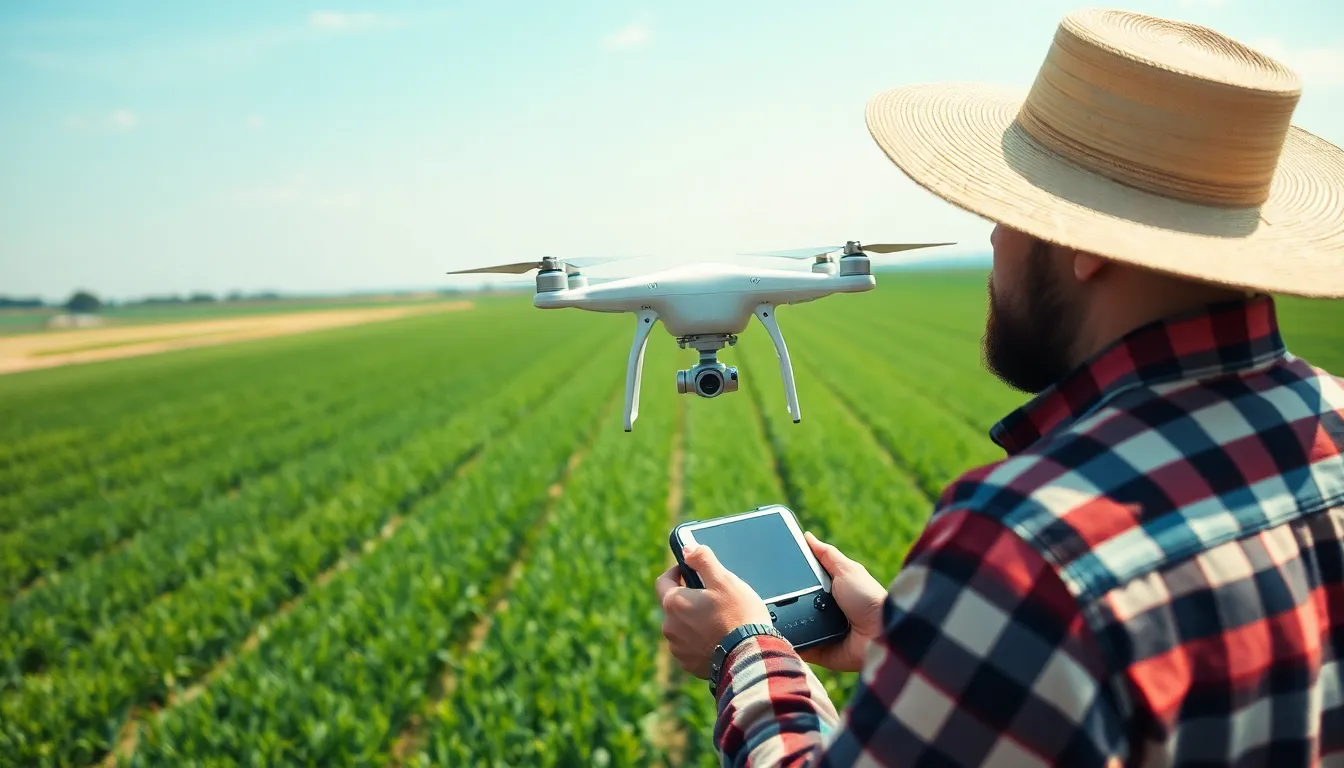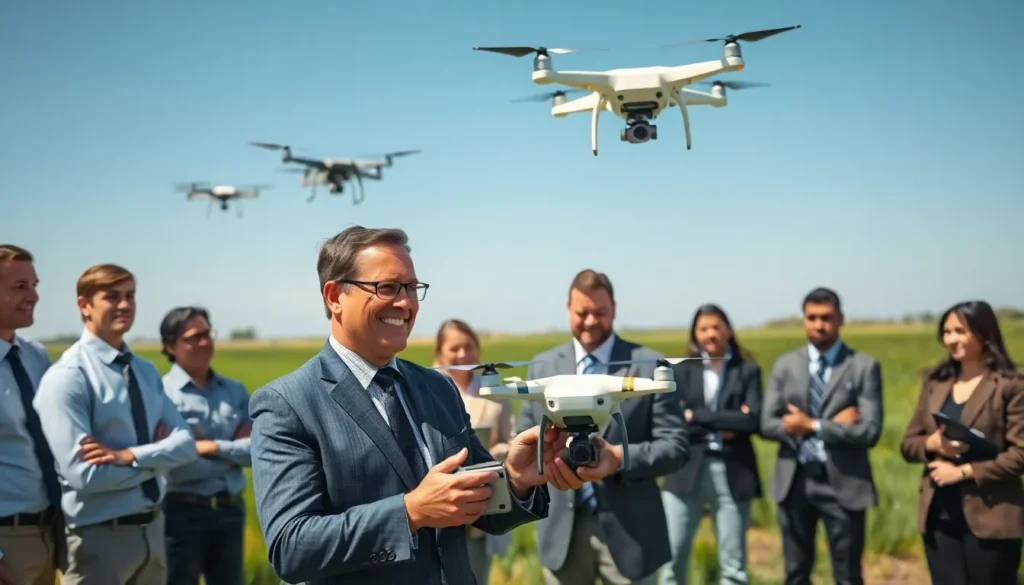The drone market is soaring to new heights, and it’s not just because they’re flying around like over-caffeinated bees. With advancements in technology and a growing appetite for aerial solutions, these buzzing gadgets are transforming industries faster than you can say “takeoff!” From agriculture to delivery services, drones are proving they’re not just toys for tech enthusiasts but essential tools for the future.
Table of Contents
ToggleOverview of Drone Market Growth
The drone market has seen remarkable expansion in recent years. According to a report by market research firm Mordor Intelligence, the global drone market was valued at approximately $22.5 billion in 2020 and is projected to reach about $42.8 billion by 2026, growing at a compound annual growth rate (CAGR) of 13.8% during this period. Such statistics reflect the rising adoption of drones across various sectors.
Aerospace and defense industries drive significant adoption. Organizations utilize drones for surveillance, reconnaissance, and logistics, recognizing their efficiency and cost-effectiveness. Agriculture also benefits greatly from drone technology, using aerial imagery and data collection to enhance crop management and yield predictions.
Delivery services transform through the integration of drones. Companies explore ways to cut delivery times and reduce costs, appealing to a tech-savvy consumer base. Retailers, like Amazon, have invested heavily in drone delivery solutions, aiming for faster service.
Regulatory frameworks evolve, enhancing market growth. Countries worldwide implement regulations to ensure safety while supporting technological advancements. The Federal Aviation Administration (FAA) in the United States creates guidelines for commercial drone operations, fostering a safer environment for their deployment.
Consumer drones gain popularity as recreational uses expand. Hobbyists increasingly adopt drones for photography, videography, and racing. The exposure arising from social media platforms, such as Instagram and YouTube, further fuels interest and demand for these devices.
Overall, the drone market continues to expand due to technological advancements and growing applications. Industries increasingly rely on drones for improved efficiency and innovative solutions.
Key Drivers of Market Expansion

The drone market expansion stems from several key influences. These factors shape growth trends and influence various industries.
Technological Advancements
Technological advancements propel the drone market forward. Innovations in battery life and software improve flight times and operational efficiency. Enhanced sensors allow for greater accuracy in data collection. It boosts applications in sectors like agriculture and surveillance. Additionally, developments in AI enable autonomous flight capabilities, reducing the need for human operators. Such advancements lead to safer and more reliable drone operations, attracting investments from various stakeholders. More organizations recognize the value of cutting-edge drone technology, significantly driving market growth.
Increasing Applications in Various Industries
Increasing applications of drones enhance market potential across multiple sectors. In agriculture, drones monitor crop health and optimize irrigation strategies. They provide farmers with valuable data to improve yields and reduce resource expenditure. The construction sector employs drones for site surveying and progress monitoring, streamlining project management. In logistics, companies utilize drones for timely deliveries, revolutionizing shipping processes. Moreover, the entertainment industry embraces drones for aerial photography and live event coverage. Diverse applications contribute to expanding market demand, illustrating the versatility of drone technology across industries.
Challenges Facing the Drone Market
The drone market encounters several challenges that could hinder its growth. Focusing on regulatory barriers and safety/security concerns showcases the complexities involved.
Regulatory Barriers
Regulatory frameworks frequently lag behind technological advancements in drone development. Authorities at global and local levels impose stringent regulations to ensure safe operations. Operating zones often remain restricted, complicating the integration of drones in various industries. Complexities in obtaining permissions can slow down market adoption. Furthermore, inconsistencies in regulations among different countries create challenges for manufacturers trying to enter new markets. The need for compliance with aviation laws adds layers of difficulty. Companies may face delays in obtaining necessary certifications, impacting innovation and deployment timelines.
Safety and Security Concerns
Safety and security issues represent significant concerns that affect public acceptance of drones. High-profile incidents involving drone malfunctions or breaches raise alarms about operational reliability. Privacy violations pose additional risks, sparking debates among stakeholders. The potential for drones to be misused for malicious purposes also elevates security fears. Mitigating these concerns requires companies to invest in advanced safety features and robust cybersecurity measures. Enhanced training for operators becomes essential to minimize accidents and ensure safe usage. Addressing these challenges is crucial for building consumer trust and supporting the long-term growth of the drone market.
Future Trends in Drone Market Growth
Emerging trends in the drone market indicate substantial advancements on the horizon. The integration of artificial intelligence and automation plays a crucial role in transforming drone capabilities.
Integration with AI and Automation
Artificial intelligence significantly enhances drone functionality. Advanced algorithms improve navigation efficiency and data processing capabilities. Autonomous flight reduces the need for human intervention, increasing operational safety. Drones equipped with AI adapt to changing environments and optimize routes, elevating performance in industries such as agriculture and logistics. This integration not only streamlines operations but also attracts significant investment, fostering market growth.
Environmental Impact Considerations
Environmental considerations shape the future of the drone industry. Sustainable practices become increasingly important as companies aim to minimize their ecological footprint. Drones reduce carbon emissions by providing efficient delivery solutions and optimizing agricultural practices. Using electric-powered drones limits reliance on fossil fuels, supporting green initiatives. As awareness of environmental impacts grows, regulatory bodies may prioritize eco-friendly technologies in drone operations, fostering a more sustainable market landscape.
The drone market is on an impressive trajectory fueled by technological advancements and diverse applications across industries. As companies continue to innovate and integrate AI into drone technology the potential for growth remains significant. Challenges such as regulatory hurdles and public acceptance must be addressed to ensure sustainable development.
With increasing awareness of environmental impacts drones offer solutions that align with green initiatives. The future looks promising as stakeholders navigate these challenges and embrace the opportunities that lie ahead. The evolution of the drone market not only enhances operational efficiency but also paves the way for a more sustainable and connected world.

